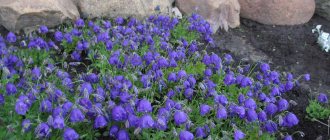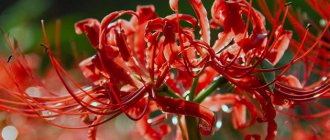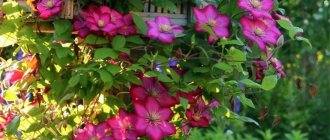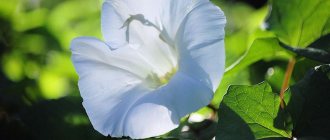Growing perennial blue cyanosis in open ground is practiced not only for the sake of its magnificent flowers, which have a delicate, refined aroma. The healing properties of cyanosis are several times higher than those of most medicinal herbs. Planting a plant in a garden plot allows you to admire the flowers for a month. There are plant varieties with blue, purple or white flowers. Caring for cyanosis is no different from traditional care for garden perennials. And the propagation of openwork bushes is accessible to a novice gardener.
Blue cyanosis: varieties and varieties
Blue cyanosis belongs to the Ciniumaceae family and is a close relative of phlox. The perennial plant reaches a height of up to 150 cm. The openwork rosette of leaves looks quite decorative without flowers. But when slender peduncles with bell-shaped flowers of bright, pure colors of blue, lilac and white rise from the center of the rosette, the plant looks elegant and impressive. A lovely subtle aroma that attracts bees adds to the attractiveness of the flowering perennial. Blueberry is an excellent honey plant.
Blueberry is a plant known for its healing properties.
There are variegated varieties of cyanosis, bred recently by breeders. Growing variegated varieties requires special attention - the plants grow more slowly and are reluctant to bloom.
Blueberry blooms in early summer, the seeds ripen in the first month of autumn. In nature, cyanosis (Polemonium caeruleum) can be found on the edges of forests and in the forest-steppes of Russia and Eastern Europe. The plant is not afraid of frost and winters well without shelter.
Healing properties of polemonium
Polemonium has healing properties. Polemonium roots have expectorant properties. In modern pharmacy, drugs with an expectorant effect are obtained from polemonium raw materials, which are successfully used in the treatment of the respiratory tract, and especially in the treatment of chronic bronchitis. In mixtures with other herbs, for example, with St. John's wort or marsh grass, it is used to treat the entire gastrointestinal tract, and directly stomach and duodenal ulcers. In combination with valerian, the roots of cyanosis azure have a mild sedative effect.
If you plan to use polemonium for medicinal purposes, then the rhizomes can be dug up starting in the second year, in the fall, when the upper part of the plant withers.
By planting polemonium in your garden, you can not only liven up your flower garden with new shades of blue, but also provide your family with free medicine from the flower bed! One more thing: don’t be afraid to plant new plants in your garden. The world of flowers is so amazing and unusual that even simply observing it makes us kinder and more sympathetic! May your good mood never leave you!
PS How nice it is to gather with the whole family by the fireplace on a winter evening, talk about plans, dream together, talk, and on a warm summer evening invite all your friends to a barbecue. Your dreams may come true! Go to kaminy-rt.ru and place an order. Fireplaces, stoves, barbecues in Kazan from various manufacturers, electric and wood-burning, with an individual design to suit any interior. Our specialists will quickly install a fireplace or stove in your home.
Images copyright flickr.com: Tom Hilton, AnneTanne, maya_dragonfly, thenikonkid, EugeneNatureObserver, hall dawson/time for catchup, shadowshador, Mikhail Ursus, flips99, hunkpapa, mdv_graupe, travelingwild, dnnya17, KingsbraeGarden, mondomuse, Tiggrx, negundo70, Isfugl, Vincent Montibus
Planting cyanosis blue
To successfully grow the crop, the cyanosis needs to be provided with constant humidity. The plant grows well in low-lying areas with high groundwater levels. The plant is demanding on soil acidity. Growing cyanosis in open ground in areas with acidic soils and high salinity is impossible.
The plant needs constant soil moisture
The plant does not tolerate drought: even short-term drying of the soil causes loss of decorativeness, disease or death of the plant. During the hot summer months, cyanosis requires systematic, abundant watering. With regular watering, the flowering of the plant in open ground lasts a little longer.
Planting cyanosis is possible in sunny places or in partial shade. When planting a plant, you should prepare the beds by adding fertile soil with humus. The soil for the crop requires fertile but light soil.
Meet polemonium or cyanosis
Polemonium is a perennial herbaceous plant that has very attractive properties and a lot of useful properties. This is a representative of the Sinyukhov family. The parameters of the plant directly depend on its type; there are figures from 50 to 120 centimeters, although shorter representatives cannot be excluded, where the height barely exceeds 20 centimeters. The foliage is very beautiful and has different lengths depending on the general parameters, the maximum size is 12 cm. The color can be either rich green or with white splashes. The inflorescences are very similar to bells, only when fully opened. The diameter of each flower also depends on the size of the plant itself, so the average varies around 1-1.5 cm, although the 4 cm mark is also found. The color scheme can be very different, ranging from white to various shades of blue - violet, lilac, lavender and blue azure. The inflorescences on the plant are not single, they are collected in bouquets and emit a very pleasant, delicate aroma. The culmination is flowering, which occurs in the first half of summer and can last a month and a half or more. The final stage of the growing season will be the formation of a fruit in the form of a box containing small seeds.
Plant care
Caring for cyanosis is not at all burdensome. During the season it is necessary to feed the plants several times. The main requirement for caring for the crop is to ensure regular watering. The plant loves water very much, but without excessive overwatering, which can cause acidification of the soil.
Several times during the summer season, you should weed the beds with blueberry, removing and destroying the weeds. An openwork bush, freed from the dominance of weeds, looks very decorative.
Be sure to remove weeds near the plant
Faded blueberry plants can be encouraged to bloom again. To do this, cut off flower stalks that have finished flowering. It should be borne in mind that it will not be possible to collect seeds from them. The second wave of azure flowers will please for a few more weeks.
Attention! When the first frost occurs, the above-ground part of the cyanosis bushes is cut out, and plant debris is removed from the beds.
How to care
As we have already said, Greek valerian does not require special care. All it needs is regular abundant watering, adding nutrients to the soil, loosening the rows and removing weeds.
Watering
The crop in question develops normally even in persistently hot weather, but this requires regular, abundant watering. The reference point for subsequent soil moisture is the dry soil around the bush. It is recommended to water the crop by sprinkling in the evening, which will ensure rapid growth of greenery and prolong the flowering period. To preserve moisture, the area is mulched with sawdust or high-moor peat.
Tip: loosen the rows to a shallow depth with special care so as not to damage the roots of the plant (they are located in the top layer of soil).
Top dressing
Fertilizers for deer grass are applied for the first time in early spring after the soil has warmed up. For this purpose, it is better to use nutrient solutions based on store-bought fertilizers balanced in composition; the liquid is poured under the root of the flower. About a week before the crop blooms, ammophos granules are scattered over the surface of the plot, which are buried deep after loosening the soil.
Trimming
After the inflorescences wither, the shoots of the plant are shortened so that they rise 25 centimeters above ground level. Carrying out such activities will contribute to the accelerated development of the root system. Do not remove all the shoots, leave a few bushes that will be used to collect seeds. Before leaving for the winter, the plants are pruned again so that small stumps up to 5 centimeters in height remain.
Fertilizer and feeding of blue cyanosis
Blueberry responds well to fertilization. It is useful to apply complex fertilizer under the roots of perennial bushes immediately after wintering. To increase the decorative appearance of flowers and the duration of flowering, in the spring the plants can be fed with superphosphate, applying fertilizer in granules under the bush. Slowly dissolving, superphosphate nourishes the plant for several months. By the beginning of summer, the plants will be ready for massive, long-lasting flowering. Fertilizing has a positive effect on the appearance of plants. Fertilizing can be done once in the summer months.
Feed the plant in early summer
Plant characteristics and nuances
At first glance, it seems that this plant is the most common and has no special requirements, so it grows successfully with minimal care. This is wrong. It should be understood that the plant has an unusual root - creeping and very little branched, so it can independently move around the site.
The flowering period is an indisputable culmination, which after the final chords becomes not at all attractive, not even very beautiful, so feel free to combine the plant with other decorative flowering representatives, perhaps with those that look larger, so that they take all the attention when the polemonium tries avoid prying eyes.
An alternative to an unsightly appearance is to completely cut the plant at the root when the flowering process is complete. The plant will begin a new round of development, new, young shoots will appear, which will not only give the plant an attractive appearance, but can even bloom again at the end of summer.
Reproduction of blue cyanosis
To propagate blue cyanosis, you should use seeds freshly collected in the fall. The fact is that long-term storage of cyanosis seeds significantly reduces their germination.
Considering that the plant tolerates cold winters well, winter sowing of seeds in furrows up to 3 cm deep is practiced. Rotted manure, complex mineral fertilizer and granulated double superphosphate are added to the soil for sowing. Previously, the beds for sowing cyanosis are dug up to 40 cm.
Advice. It is allowed to sow cyanosis in open ground in early spring. But when sown in winter, the plants begin to bloom several weeks earlier.
Sprout of cyanosis
Reproduction methods and influence on planting technology
There are three ways to propagate polemonium, so the planting technology depends on the choice of the method you like. Let's figure out how to plant polemonium in all possible ways.
- Propagation by seeds. Flowering ends with the formation of seed pods, which, after ripening, produce a sufficient number of seeds that can be sown at different times of the year - in the fall, before winter, or in the spring of the new year. Autumn planting is the simplest, since the seeds undergo natural stratification, so there is no need for additional manipulations with planting material. But in the spring, seeds should be planted only after artificial stratification in the refrigerator, or by seedling method. Remember, although seedlings are a more troublesome process, you get flowering already in the first year of the growing season. The seeds should be sown to a depth of two centimeters, and within three weeks you will get full-fledged seedlings.
- Reproduction by root division. This method is considered the simplest and most effective, since the adult plant immediately continues its growing season, thereby not slowing down the flowering process. The division procedure is classic, there are no subtleties or nuances, everything is according to the rules. It should be understood that dense plantings are not for polemonium, so try to maintain the required distance from thirty centimeters to half a meter.
- Propagation by cuttings. This method is also popular and practical, it involves rooting the cut tops. The dimensions of the cutting should barely exceed 10 cm. Planting does not occur immediately in the selected area, but somewhere under the tree. Create a greenhouse from a regular plastic bottle with a cut. Water and observe, as soon as the plant begins to form a root system, it will definitely let you know and begin to grow. When the plant gets stronger, it can be transplanted to a permanent place; it is not afraid of transplants.
Blue cyanosis: combination with other plants
Perennial blue cyanosis bushes go well with perennial plants of equal height: bluebells, speedwell, catnip, popovnik, rudbeckia, digitalis.
The undemanding nature of cyanosis in terms of lighting allows this plant to be planted in partial shade, where it fits into compositions with shade-loving plants: bergenia, hosta, mantle, loosestrife; the combination of cyanosis with ferns is especially picturesque.
Cyanosis in the country garden
In an open sunny place, cyanosis can be planted with geraniums, cornflower, gaillardia, and gatsaniya. Photos of such flower beds confirm the decorative qualities of cyanosis.
Decorative deciduous varieties of cyanosis look great against the background of the bright greenery of ornamental shrubs and low conifers: cotoneaster, thuja, cypress.
Already in September, cyanosis changes the color of the leaves from green to bright lemon color. This feature of the plant adds decorativeness to the composition with evergreen conifers.
Varietal diversity
Sinyukha Alba
In nature, there are up to 50 representatives of blue crops. The main species are multi-leafed, creeping, and petaled grasses, but the most popular among gardeners is blue cyanosis.
Main varieties:
- Blueberry Alba is an ornamental crop up to 1 meter tall. The flower is unpretentious in care, withstands drought and freezing temperatures well, and does not need shelter for the winter. Leaves are green, dissected. The color of the inflorescences is white, the size is medium.
- The Bambino blue variety is a herbaceous perennial up to 80 centimeters tall with a slightly curved stem and dissected leaf blades. The flower is resistant to drought and sudden temperature changes. The inflorescences are racemose with bright blue petals.
- Blueberry Вrise d anjou is considered a rare exotic crop; it differs from the rest in its beautiful variegated leaves and bright flowers. The surface of the leaf blades is green with a cream rim. The flowering of the crop begins in July, at which time numerous blue inflorescences appear above the dense foliage.
- The Purple rain strain variety is considered a compact plant. It has feathery green leaves. In spring the foliage turns purple, in summer it is green, and in autumn it turns red. Bushes up to 60 centimeters in height, inflorescences lavender blue.
Blue cyanosis in landscape design
An undemanding perennial plant is successfully used in landscape design to create multi-level flower beds with prolonged flowering. The pure tones of cyanosis flowers are in perfect harmony with the colors of other plants.
Dense cyanosis bushes will perfectly hide country outbuildings
Bluegrass is indispensable in landscape design for decorating fences and walls of utility buildings, as well as for creating mixborders. Curtains of different varieties of cyanosis plantings look very picturesque: a bright combination of blue and white flowers is often used for decorative purposes.
In landscape design, the plant is successfully used to decorate ponds.











